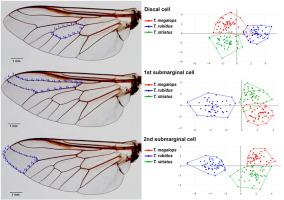利用基于轮廓的翼细胞轮廓几何形态计量学区分形态上相似的三个 Tabanus 种(双翅目:Tabanidae)的初步见解
IF 1.7
Q3 PARASITOLOGY
Current research in parasitology & vector-borne diseases
Pub Date : 2024-01-01
DOI:10.1016/j.crpvbd.2024.100218
引用次数: 0
摘要
由于马蝇(双翅目:Tabanidae)是各种病原体的传播媒介,因此准确鉴定马蝇的种类至关重要,这对于了解其生物学特性、制定控制其种群的策略以及加强疾病监测至关重要。本研究评估了基于轮廓的几何形态计量学(GM)的有效性,通过分析翅盘、第一近缘细胞和第二近缘细胞的翅细胞轮廓来区分泰国常见的三个形态相似的 Tabanus 种:T. megalops、T. rubidus 和 T. striatus。统计分析表明,T. rubidus与其他两个物种的体型差异显著(P < 0.05),T. rubidus的翅细胞更大。Tabanus megalops和T. striatus的体型相似;它们的体型差异没有统计学意义。基于有效分类测试的尺寸分析准确率相对较低,从 64.67% 到 68.67%。尽管如此,所有翼细胞轮廓在三个物种之间都显示出显著的形状差异,这一点通过使用 1000 次置换检验(P < 0.05)进行 Mahalanobis 距离比较得到了证实。第一个近缘细胞轮廓的形状显示出最高的分类准确率(86.67%)。基于轮廓的基因组学在分析细胞完整但翅膀不完整的苍蝇标本时具有显著优势。对于受损的标本,通过该技术分析第一个近缘细胞的轮廓也是一种可行的替代方法。本文章由计算机程序翻译,如有差异,请以英文原文为准。

First insights into using outline-based geometric morphometrics of wing cell contours to distinguish three morphologically similar species of Tabanus (Diptera: Tabanidae)
Accurate species identification of horse flies (Diptera: Tabanidae) is crucial due to their role as vectors for various pathogens, which is essential for understanding their biology, devising strategies to control their populations, and enhancing disease surveillance. This study assessed the efficacy of outline-based geometric morphometrics (GM) by analyzing the wing cell contours of discal, first submarginal, and second submarginal cells to distinguish three morphologically similar Tabanus species commonly found in Thailand, T. megalops, T. rubidus, and T. striatus. Statistical analysis demonstrated significant size differences between T. rubidus and the two other species (P < 0.05), with T. rubidus exhibiting larger wing cells. Tabanus megalops and T. striatus had similar sizes; their size differences were not statistically significant. The accuracy of size analysis based on validated classification tests was relatively low, ranging from 64.67% to 68.67%. Nonetheless, all wing cell contours showed significant shape differences between the three species, as confirmed by Mahalanobis distance comparisons using 1000 permutation tests (P < 0.05). The shape of the first submarginal cell contour showed the highest classification accuracy (86.67%). Outline-based GM offers a significant advantage for analyzing fly specimens with incomplete wings that have intact cells. For damaged specimens, analyzing the contour of the first submarginal cell through this technique can be a viable alternative.
求助全文
通过发布文献求助,成功后即可免费获取论文全文。
去求助

 求助内容:
求助内容: 应助结果提醒方式:
应助结果提醒方式:


